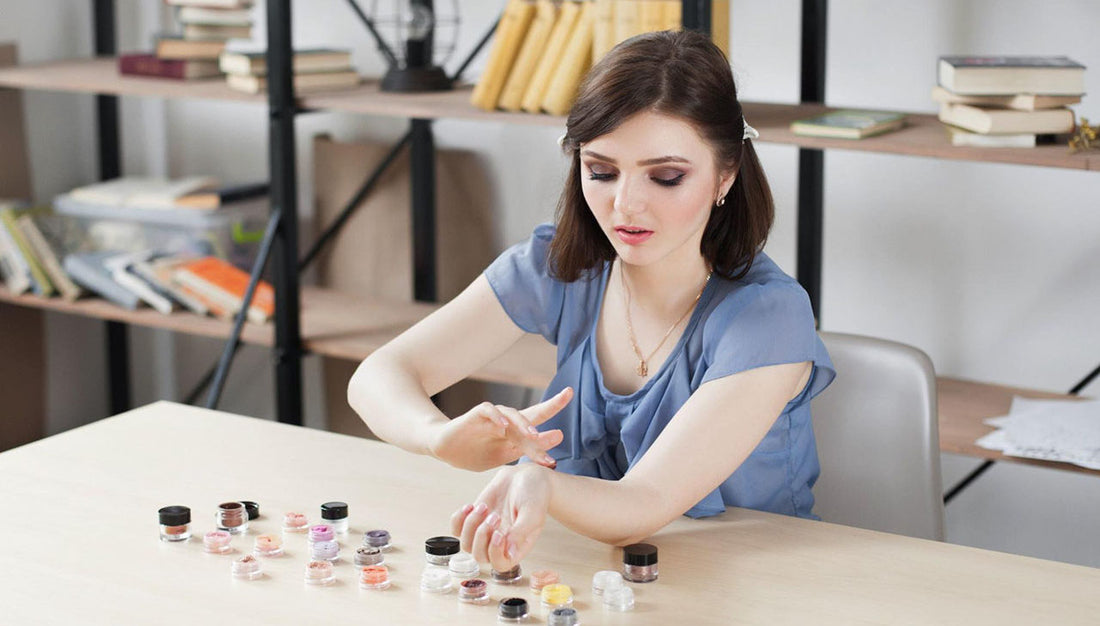Key takeaways
- To create a safe, effective product, perform in-depth market research and take time to develop and test your product
- Research government regulations and required permits for your cosmetic product, especially if it’s classified as a drug
- Create a distribution strategy before you launch to ensure a smooth customer experience
If your medicine cabinet feels more like a storage unit for makeup products, or the skincare aisle is always calling your name, you’re not alone. For many people, beauty products are splurge-worthy expenses they can’t live without. The average American spends between $244 and $313 on cosmetics every month, resulting in nearly $50 billion in sales each year.
By learning how to start a cosmetic business, you can capitalize on massive consumer demand for all things beauty. Getting into the cosmetic industry can help you turn your beauty passion into revenue, and you can even fill industry gaps for groups that may not be able to find brands that fit their needs. Here’s what you need to know to develop your own cosmetic products and launch a successful brand.
How to start a cosmetic business: 11 steps to launch
The cosmetics industry is competitive. Consumers can choose from thousands of beauty brands, both in-store and online. But in an industry that’s constantly chasing the latest trend or hottest makeup line, there’s always room for new startups. With these 11 steps, you can take your own business in the right direction.
1. Choose a cosmetic product to develop
The beauty industry covers a broad range of products, from haircare and skincare products to cosmetics and perfumes. The first step to starting a cosmetic business is identifying the type of product (or products) you want to develop. For example, if you’re planning to launch your own makeup line, you might focus on developing an eyeshadow palette. If your startup is focused on haircare, you might develop a shampoo and conditioner set.
Most beauty brands launch with fewer than five products, including variations of the same formula—such as concealer shades or eyeliner colors. While you might eventually launch a broader cosmetic line, developing products can be costly, time-consuming, and complex. As a startup, launch with a few high-quality products that will appeal to your target market rather than a variety of mediocre items that could hinder your success.
2. Perform market research
Finding your niche in the crowded beauty industry is key to standing out. Market research can help you identify gaps in the current beauty market—like underserved demographics, rising trends, or unmet needs.
As part of your ideation and launch preparation process, do thorough online research, consult industry surveys, and conduct interviews with beauty consumers to learn about:
- The products they love and why they love them
- The pain points they have with competitors’ beauty products
- The beauty trends they’re following
- How much they’re willing to spend on different kinds of products
Once your market research is complete, identify how you can meet your potential customers’ needs and what makes your products unique. For example, you could specifically focus on creating semi-permanent hair dyes for natural hair.
3. Research local and federal regulations

Cosmetic products are heavily regulated by the Food and Drug Administration (FDA). For example, the FDA sets strict limitations on the types of color additives you can use in cosmetics, which varies depending on where your product will be applied on the body.
To ensure you adhere to federal regulations for your flagship products, first learn out how the FDA classifies your product.
Products applied for cleansing or beautifying—like bronzers and nail polishes—are cosmetics. But those that double as a treatment—such as toothpastes with fluoride or lotions with SPF—can also be classified as drugs, which must meet stricter requirements for registration, labeling, and more. Learning how to launch an anti-dandruff shampoo brand can be more complex than learning how to start a makeup line that’s purely for beautification.
Once you know the FDA‘s requirements for your beauty business, research local regulations, such as permits required in your state or city. Your local Small Business Administration district office can point you in the right direction.
4. Choose a business name
After you’ve solidified your business idea, the next step is choosing your business name. Brainstorm ideas that evoke what makes your brand unique. Instead of generic names like “Makeup Co.,” aim for something more creative and descriptive, such as “True Bloom Organic Beauty.”
Once you’ve narrowed down your top name choice, make sure it’s legally available. No two businesses in the same industry can share a name in the same state—or anywhere if it’s trademarked. Your state government’s business name search tool, like the Arizona Secretary of State’s entity search, and the U.S. trademark database can help.
Doing a search on Namechk can help you choose a business name that’s available as a domain, social media username, and more. Having a consistent name across all channels is crucial for marketing, especially if you plan to operate as an ecommerce business.
In this stage, you can also start brainstorming product name ideas, which you solidify in product development.
5. Create a business plan

Writing a business plan is another key step toward building your company. A business plan helps you plan for the future, demonstrate your potential to outside lenders, and partner with retailers.
While a business plan document largely serves to introduce you and your company, it also allows you to solidify your marketing and financial plans. As part of your business planning process, create a marketing strategy that outlines how you’ll reach your target audience. For example, to reach younger clients, you can partner with influencers like local makeup artists or promote your brand with TikTok tutorials.
You’ll also need to create a financial plan for your small business. List your expected startup costs—including product development and business registration fees—as well as monthly operational costs, such as manufacturing, warehouse rental, shipping, and digital advertising.
6. Register and license your business
To legally form your company, first decide on your business structure: Will it be an LLC or an S corporation? Your business structure impacts your personal liability and the way you’re taxed. Visit your state agency’s website or office to complete your business registration.
In addition to registering your new business in-state, you can also apply for an employer identification number (EIN), which is required for corporations, partnerships, and any businesses with employees. Even if you operate a sole proprietorship, you may need it to open a business bank account or get loans.
If your local government requires permits or licenses for cosmetic businesses, start registering for those too.
7. Get funding for your business
Learning how to start a cosmetic business often requires funding, either from financial institutions or crowdsourced resources. You’ll start incurring startup costs as you begin product development—so it’s important to fundraise or reach out to lenders early.
Start by totaling up your expected startup costs and your operational costs for the first six months. Consider whether you have the funds to cover these expenses. If not, you’ll need to decide how you’ll get funding for your business, whether it’s by crowdfunding, applying for business credit cards, getting bank loans, pitching to investors, or something else.
8. Begin product development

With plans laid out and funding set, you can start developing your first cosmetic product. Once you create your first product or product line, you can also solidify your pricing strategy, product branding, and more. If you plan to develop your product on your own, research how to create cosmetic formulations that are both safe and effective You’ll need to finance the raw materials, containers, and other packaging. This is a good approach for products that are easy to DIY, such as soaps and organic makeup (think items you’d find on Etsy), rather than chemical-based products like sunscreens and toothpastes.
Alternatively, you can outsource the work to a professional cosmetic scientist, which typically costs at least $1,000 per product. After your product is developed, either pack and ship it on your own or find a manufacturer to help. The Society of Cosmetic Chemists can help you find a scientist to work with.
You can also work with a private label manufacturer—which you can find on sites like Alibaba or Thomasnet—and skip costly parts of the development phase. By selling a pre-developed formula with your own branding, you’ll only have to pay per unit (wholesale prices).
Regardless of how you create your product, be vigilant about the ingredients you’re using—especially if you’re making claims like “paraben-free” or “organic”—and how you’re labeling your products.
9. Test your new product
When product development is complete, create or order samples before you build your inventory. Thoroughly test the quality of your product and ensure it does what you promise—for example, your mascara should stay on through a shower if it’s waterproof. You can recruit friends, family members, and potential customers to help you test the products. Testers should inform you of any bad reactions to your product, even if they’re minor.
This step can ensure your product is safe, which is crucial, since cosmetic businesses can be held accountable for safety problems. Before you administer any tests, research existing safety data for your ingredients and similar formulas on the Cosmetic Ingredient Review website.
For products that take time to produce results (such as retinol serums), the testing phase may take over a month. Some cosmetic scientists may also offer testing services for around $500 to a few thousand dollars or include it with your product development costs.
10. Create a distribution strategy
Before you launch your cosmetic business, take some time to flesh out your business model. You’ll likely have an online store, but you can also identify brick-and-mortar retailers you want to work with or local markets where you want to sell.
For online orders, outline how you will get products to consumers. Ask yourself questions like:
- Will I pack and ship products myself or work with a distributor?
- What software will I use to manage orders and inventory?
- What order updates (like shipping updates or order confirmations) will clients receive?
Outline your client management strategy here as well. If issues occur during the distribution process, how will you notify customers of delays? Consider how clients can reach out to you if they need help. Write return and cancellation policies that you can display on your website.
11. Build and launch your online presence
The last step before launching your cosmetic business is ensuring customers know where to find you—by creating an engaging online presence. Start by building your online store or ecommerce site using a website builder like Squarespace. You can also create a storefront on marketplace sites like Amazon and Etsy.
To market your store, create social media profiles on platforms your target customers use. If you sell products in-person to local clients—such as at a farmer’s market, kiosk, or retail space—you can also claim your Yelp Business Page to reach customers actively looking for beauty products. And don’t forget to create appealing signage to stand out from the crowd.
Launch your first cosmetic line
When you know how to start a cosmetic business, you can build a lucrative brand and cultivate a loyal customer base. Successful business owners in the beauty industry prioritize extensive market research and product development for high-quality results. Be prepared to market and fund your business while managing clients with grace.
Once you’ve launched your first cosmetic line, learn how to attract more customers to your business with this step-by-step guide.

